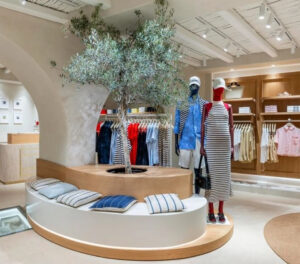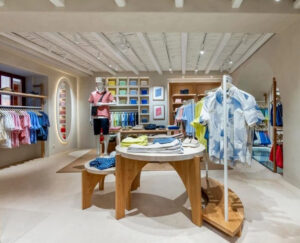
In an increasingly globalized world, brands are constantly seeking innovative ways to resonate with consumers across diverse markets. One of the most effective strategies to achieve this is by adhering to local culture and architecture, creating an immersive and authentic experience that connects with the community while staying true to the brand’s identity. Whether it’s luxury retail, hospitality, or lifestyle brands, blending modern design with local heritage fosters a deeper emotional connection with customers and enhances brand credibility.
In this article, we explore why brands should align with local culture and architecture, how it can create a memorable experience, and key examples of successful implementation—such as Tommy Hilfiger’s minimalist retail store design in the Greek Islands, which harmonizes with the region’s architectural essence while reflecting the brand’s global aesthetic.
Why Brands Should Embrace Local Culture & Architecture
Strengthening Cultural Relevance
Adapting to local culture and architectural styles allows brands to demonstrate an appreciation for heritage, positioning themselves as culturally aware and sensitive to the unique characteristics of each market. This helps in:
•Building trust and authenticity by showing respect for local traditions.
•Attracting local consumers who identify with their surroundings.
•Enhancing storytelling, as architecture can become a physical embodiment of the brand narrative.
Differentiation in a Competitive Market
In a crowded retail landscape, creating a unique experience is key to standing out. A store design that reflects local aesthetics offers an edge by blending the brand’s identity with the distinctive essence of the location. This differentiation can:
•Make the store a landmark attraction, drawing customers beyond the product offerings.
•Create social media appeal, as consumers are more likely to share visually striking and culturally resonant spaces.
Enhancing the Customer Experience
A retail environment that aligns with local architectural elements can enhance the sensory experience for shoppers. When customers feel a connection between the space and their cultural background, it results in:
•Increased engagement and emotional attachment.
•Longer store visits, as the environment feels more comfortable and familiar.
•A multi-sensory journey, where traditional materials and designs contribute to a holistic brand experience.
Aligning with Sustainability Goals
Incorporating local materials and architectural techniques can contribute to sustainability efforts. Many traditional architectural styles are developed in harmony with the environment, using locally sourced, eco-friendly materials that reduce the carbon footprint and support local economies.
How to Create a Memorable Experience On Brand and On Message
For a successful localization strategy, brands must find the right balance between global consistency and local authenticity. Here are some key principles to achieve this balance:
Architectural Adaptation with a Brand-Centric Approach
While incorporating local architectural elements, brands should ensure that the design remains aligned with their core identity. This can be done by:
•Selecting elements that complement the brand’s signature aesthetic without overwhelming it.
•Merging modern materials with traditional craftsmanship, creating a fusion of old and new.
•Customizing the design to ensure it feels organic yet distinctly branded, much like Tommy Hilfiger’s Greek Islands store, which reflects both Cycladic architecture and the brand’s signature minimalism.
Honoring Cultural Symbols and Motifs
Integrating cultural symbols, patterns, and motifs into store design offers a visual connection to the region. However, brands should do this with cultural sensitivity by:
•Conducting research to avoid cultural appropriation.
•Working with local artisans and architects to ensure authenticity.
•Using motifs subtly to enhance, rather than overshadow, the brand experience.
Material Selection and Sustainability
Brands can embrace sustainability while adhering to local architectural aesthetics by utilizing:
•Locally sourced materials such as stone, wood, or textiles that reflect the region’s character.
•Traditional building techniques that promote energy efficiency and durability.
•Biophilic design elements, such as integrating natural lighting and greenery, that align with both cultural and environmental values.
Localized Storytelling
A well-designed space should tell a story that resonates with local customers while maintaining the brand’s overarching narrative. Effective storytelling involves:
•Creating experiential zones that reflect the local way of life.
•Curating visual displays and product arrangements that highlight regional influences.
•Incorporating cultural narratives into marketing materials, enhancing the in-store experience.
Seamless Integration of Technology
While embracing local culture, brands should also integrate modern technology to enhance convenience and engagement. This could include:
•Digital storytelling elements that educate visitors about the intersection of the brand and local heritage.
•Augmented reality (AR) features that showcase the evolution of local architecture.
•Smart retail solutions that cater to local preferences and shopping behaviors.
Case Study: Tommy Hilfiger’s Retail Store in the Greek Islands
A perfect example of balancing local culture with brand identity is Tommy Hilfiger’s retail store in the Greek Islands. Known for its crisp, nautical-inspired designs, the brand effortlessly adapted its signature aesthetic to complement the Cycladic architecture of the region.
Key Design Elements:
Minimalist White Exteriors:
•The store’s facade embraces the traditional whitewashed aesthetic of Greek island homes while maintaining the clean, sophisticated lines that reflect Tommy Hilfiger’s modern appeal.
Blue Accents Inspired by the Aegean Sea:
•Subtle hints of blue in the store’s interiors pay homage to the region’s vibrant color palette while aligning with the brand’s nautical theme.
Natural Stone Flooring:
•Local materials, such as marble and stone, were incorporated into the flooring to blend authenticity with luxury.
Open-Air Design Concept:
•The store features open spaces and natural light, enhancing the feeling of an island getaway while creating a relaxed shopping experience.
Through this approach, Tommy Hilfiger successfully created a shopping destination that feels both distinctly local and inherently on-brand, proving that cultural alignment and branding can coexist harmoniously.
Final Thoughts
As global brands expand into new markets, the need to honor local culture and architecture becomes increasingly essential. Beyond just selling products, brands have the opportunity to create meaningful, memorable experiences that resonate with local communities.
By embracing the principles of localized design—such as integrating local materials, respecting cultural heritage, and blending modernity with tradition—brands can establish deeper connections with their audience while remaining authentic to their identity.
Ultimately, brands that successfully navigate this intersection will not only enhance their reputation but also create spaces that are On Brand and On Message, fostering loyalty and admiration across generations.
No comments yet.








